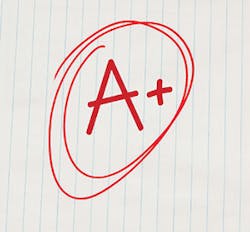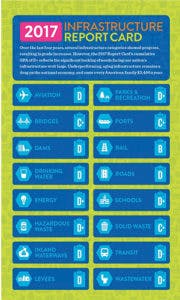“Grade me!” Lisa begs in an early episode of The Simpsons. “Grade me! Look at me! Evaluate and rank me!” She keeps it up until her mom Marge scribbles an “A” on a piece of paper.
Honestly, we’re not that needy, and we’re certainly not looking for an easy A, but the stormwater community is asking for a grade. You can help.
Along with the editors of Forester’s other publications—all of which deal with various aspects of infrastructure—I have mentioned ASCE’s Infrastructure Report Card many times. Every four years, the American Society of Civil Engineers grades US infrastructure in several areas. The report card is an extremely useful tool for giving people, inside and outside the sectors in question, a big-picture look at the state of our roadways, railways, airports, energy systems, water and waste disposal facilities, and the many other essential pieces that keep the country going. It highlights critical needs and funding shortfalls. And, importantly, it provides an easily understood and sound-bite-friendly way to communicate that information to the general public who might not otherwise give much thought to infrastructure. After all, who doesn’t like grades?
ASCE’s latest report card came out earlier this year, and the overall grade was a dismal D+. The water-related categories fared even worse. Inland Waterways, Drinking Water, Dams, and Levees each received a grade of D, and Wastewater received a D+. But this year, as in the past, there has been no category specifically for stormwater.
That may be changing. A movement is afoot to assign a grade to stormwater. A survey is available on the website of the National Municipal Stormwater Alliance at www.nationalstormwateralliance.org/reportcard. Because stormwater—and urban stormwater runoff, the only growing source of water pollution—impacts so many industries, says NMSA on its site, the organization is looking for input from people both inside and outside the stormwater sector. Categories include capacity, condition, funding, future need, operations and maintenance, public safety, resilience, and innovation; you can give a grade of A through F to each of these categories separately. The survey is detailed enough to gather valuable information, but not so long that it will take too much of your time to complete.
Other countries—Canada and New Zealand—include stormwater in their own infrastructure report cards, as do various states and counties. NMSA intends for its stormwater report card to complement ASCE’s existing categories and possibly to nudge ASCE to include stormwater as a separate category on its future report cards. A report will be prepared by the end of the year, so NMSA is looking to wrap up its survey by November 30. That gives you a couple of weeks to participate.
About the Author
Janice Kaspersen
Janice Kaspersen is the editor of Erosion Control and Stormwater magazines. She works with experts throughout the erosion and sediment control industry and the stormwater industry to produce articles relevant to professionals working in both of these fields. Topics covered regularly in the magazines include best management practices for erosion control and stormwater management; green infrastructure, such as bioswales, rain gardens, pervious pavement, and rainwater harvesting systems, as a supplement to traditional “gray” infrastructure; stormwater management and erosion and sediment control techniques for construction sites; urban retrofit and redevelopment; and the many evolving Clean Water Act regulations. She has researched and written articles on topics ranging from coastal erosion to stormwater program funding.
Janice also puts together the speaker program portion of Forester Media’s StormCon, the North American Surface Water Quality Conference and Exposition, which is in its fourteenth year. The annual StormCon conference brings together surface water professionals, engineers, municipal program managers, researchers, regulators, and others concerned with water quality. Conference program tracks include Best Management Practices, Green Infrastructure, Stormwater Program Management, Water-Quality Monitoring, Advanced Research, and Industrial Stormwater Management.
Before joining Forester Media, Janice worked as a technical writer and editor for a government research laboratory. She has a degree in English and anthropology from the University of Arizona. She holds a certification from the Board of Editors in the Life Sciences.



